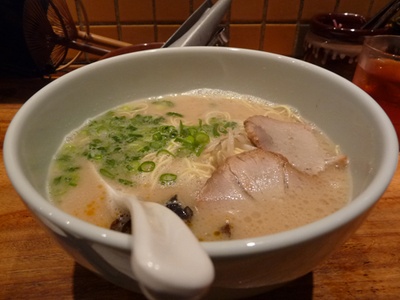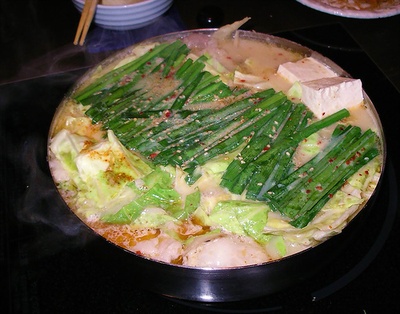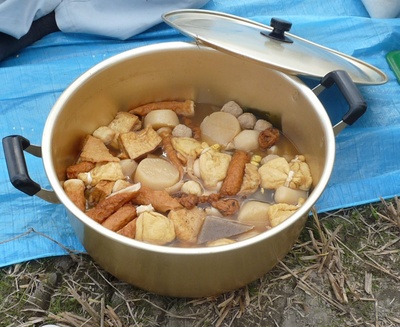A província de Fukuoka também é conhecida por sua variedade e qualidade gastronômica. No topo da lista dos famosos pratos está o “Hakata Ramen”. As características que dão o gosto especial ao Hakata Ramen são o caldo feito à base de carne e ossos de porco e a textura firme do macarrão, apresentando um cheiro bem forte. Recomenda-se comer o macarrão antes de se tornar demasiadamente macio. Além das coberturas básicas de fatia de porco assado e cebolinha picada, você pode escolher coberturas adicionais como gengibre, gergelim e pimenta. Em muitos restaurantes, após comer todo o macarrão, você pode pedir uma nova porção só da massa como se fosse um refil para comer com a deliciosa sopa restante. Depois de descobrir o gosto de Hakata Ramen, acho que vou ficar com saudades quando retornar ao Brasil e não verei graça nenhuma em lamen1 do tipo macarrão instantâneo.
Outra comidinha típica de Fukuoka é o Mentaiko. Mentaiko é ova de peixe curtida em molho de pimenta. É bastante popular e tem gosto picante e textura granular característicos. As pessoas em Fukuoka gostam de apreciá-lo com o arroz quente, o alimento básico do Japão. Também é utilizado no preparo de pratos de massas e podem ser encontrados em forma de snacks de Mentaiko. O Mentaiko originou-se na cozinha coreana e foi introduzido no Japão após a Segunda Guerra Mundial, tendo sido adaptado ao gosto japonês, em Fukuoka, em 1950. O tempero e o sabor são ligeiramente diferentes na Coréia e uma variedade comum é o Mentaiko picante (karashi mentaiko ). O Mentaiko é feito em uma variedade de sabores e cores e está disponível em aeroportos, lojas e estações de trem.
O doce mais famoso em Fukuoka é o Hakata Torimon, que conquistou a medalha de ouro da Monde Selection por anos consecutivos desde 2001. Monde Selection é considerado o “Oscar” dos produtos comestíveis, no qual anualmente são apreciados milhares de produtos de fabricantes do mundo inteiro, sendo realizado em Bruxelas, na Bélgica, desde 1961. O Hakata Torimon é um bolinho com recheio de creme e manteiga. É uma mistura de sabor tradicional japonês com o ocidental. A textura da parte externa e o recheio macio formam uma combinação gostosa. Este doce é indicado como omiyage2 de Fukuoka.
Também famoso é o Chidori Manju, que é um outro bolinho doce assado com uma marca característica de um pássaro chamado plover . Ficou bastante tempo conhecido pelas pessoas como um dos melhores doces de Fukuoka. A parte úmida de fora e a sofisticada doçura do recheio de feijão branco também resultam em um ótimo equilíbrio de sabor.
Motsunabe é uma panela quente contendo carne de porco ou miudezas de bovino (motsu ) cozidos em uma sopa com repolho e cebolinha. O prato é preparado na frente do cliente, do início ao fim. As pessoas costumam pedir para acrescentar arroz ou macarrão para a sopa restante, que pode ser apreciada sozinha, pois é muito saborosa. É conhecido como um prato nutritivo e pouco calórico e talvez por isso, bem popular entre mulheres.
Além dos pratos que podem ser encontrados durante o ano todo, há aqueles sazonais. Oden, por exemplo, é um prato japonês consumido mais comumente no inverno, que consiste em um ensopado japonês que faz uso de ingredientes populares como konnyaku (espécie de gelatina feita de batata), daikon (nabo japonês), tofu (queijo de soja), ovos inteiros cozidos e pasta de peixe cozida chamada de chikuwa imersos em um caldo feito à base de molho de soja (shoyu ) e peixe. Os ingredientes podem variar conforme o costume e disponibilidade local.
As vendas de alimentos em barracas ao ar livre também são características de Fukuoka. São chamados de Yatai e conhecidos como símbolo da cidade. Existem mais de 150 Yatai por toda a cidade, com maior concentração na região central e em distritos de Tenjin.
Os pratos típicos que podem ser apreciados nos Yatai são o Oden, o Hakata Ramen (ambos mencionados anteriormente), espetos de frango grelhado (yakitori ) e gyozas (pastéizinhos de origem chinesa). Várias bebidas alcoólicas também estão disponíveis e tornam os Yatai lugares para entrar em contato com os habitantes locais, embora alguns dos freqüentadores sejam turistas japoneses vindos de outras partes do Japão. Os Yatai normalmente começam a funcionar cerca de seis da tarde, exceto quando o tempo está muito ruim. Muitas barracas só funcionam aos finais de semana e é comum o trabalho em família. O porém é que não se pode esperar tanto da qualidade do atendimento. O horário de encerramento varia de estande para estande e alguns deles funcionam até o meio da madrugada.
O churrasco japonês é bem diferente do brasileiro. Com a ajuda de pegadores e hashi3 são preparadas carnes em fatias bem finas, linguicinhas e asinhas de frango. Não tem comparação, come-se muito menos carne do que em churrascos brasileiros. Enquanto as carnes são servidas, também são preparados peixes inteiros com tempero bem leve, enrolados em papel alumínio. Os tradicionais onigiris4 acompanham o churrasco. Depois, é a vez dos vegetais: repolho, cebola, abóbora, pimentão. Para nossa surpresa, ao final, acrescenta-se macarrão de yakisoba aos vegetais que sobram. Cerveja também é uma das bebidas servidas, como no churrasco brasileiro.
É claro que as outras províncias do Japão também têm pratos e doces muito gostosos, que inclusive já pude provar, mas eu preferi revelar neste mês o que Fukuoka tem de bom!
Notes:
1. Lamen (ramen ) é um alimento japonês de origem chinesa composto por filamentos longos de massa alimentícia com ervas e legumes temperados com carne de porco ou peixes.
2. Omiyage significa souvenir . No Japão, é comum comprar-se omiyages para serem compartilhados com os companheiros de trabalho e com familiares. As vendas de omiyage transformaram-se em um grande negócio nos pontos turísticos do Japão. São vendidos também em estações de trem e aeroportos, de forma que os turistas possam comprar um omiyage de última hora antes de voltar para casa.
3. Hashi são os palitinhos da culinária japonesa.
4. Onigiri é um bolinho de arroz japonês geralmente em forma de triângulo, ou de forma ovalada envolto por uma folha de nori .
© 2009 Silvia Lumy Akioka









